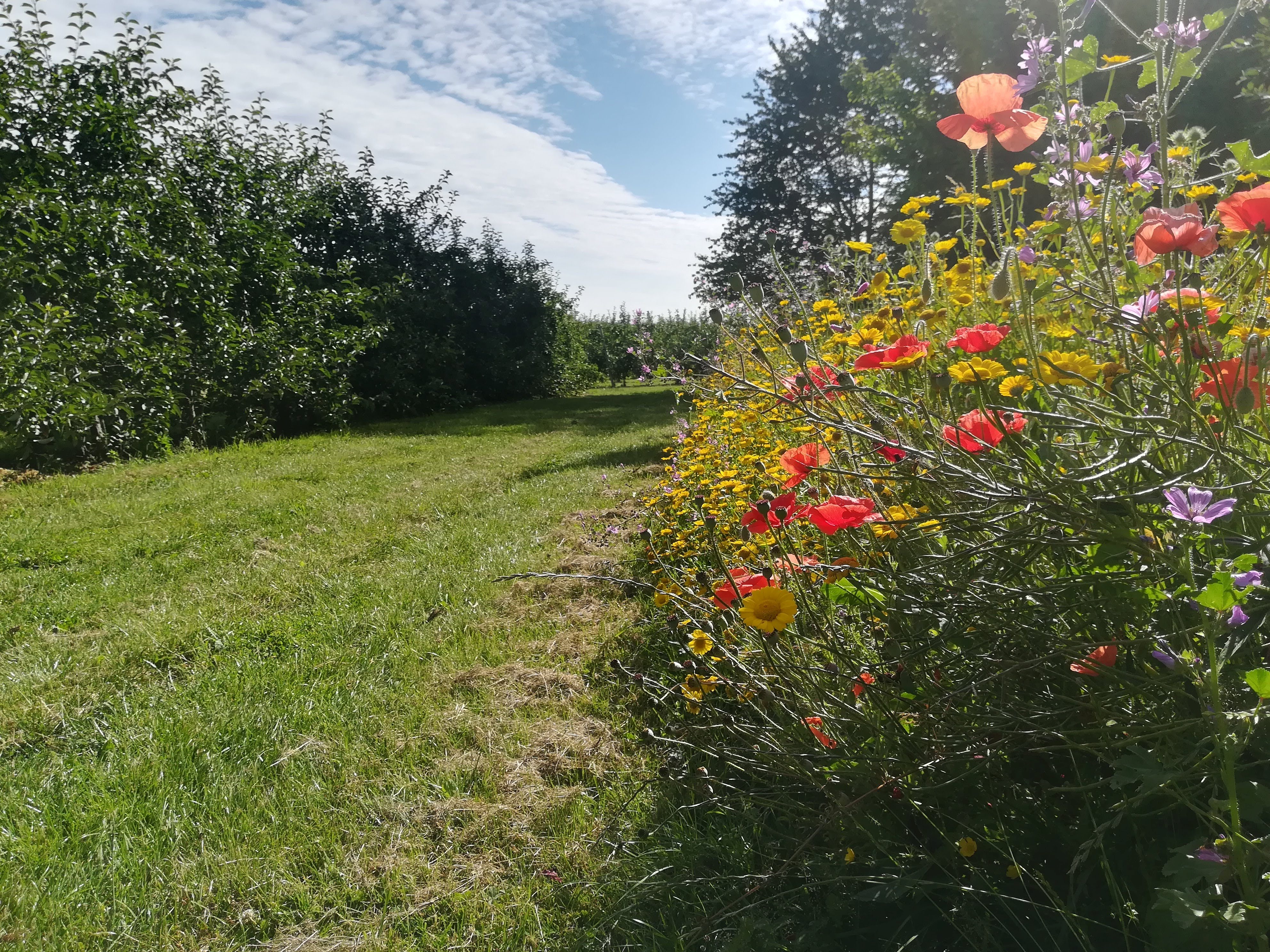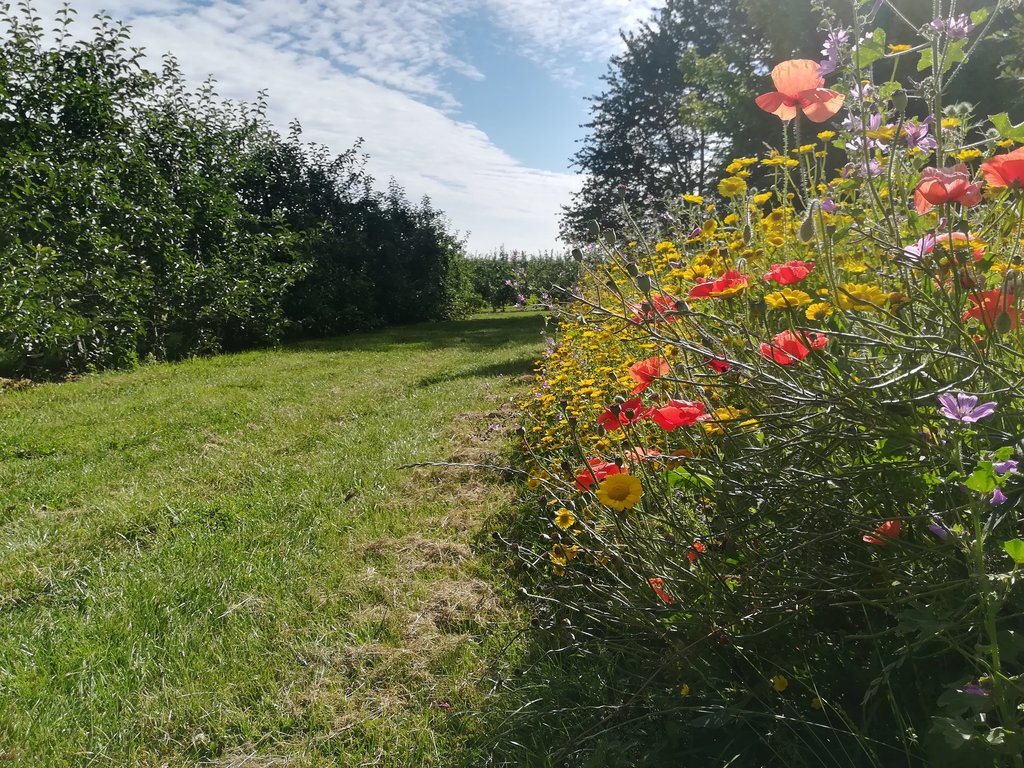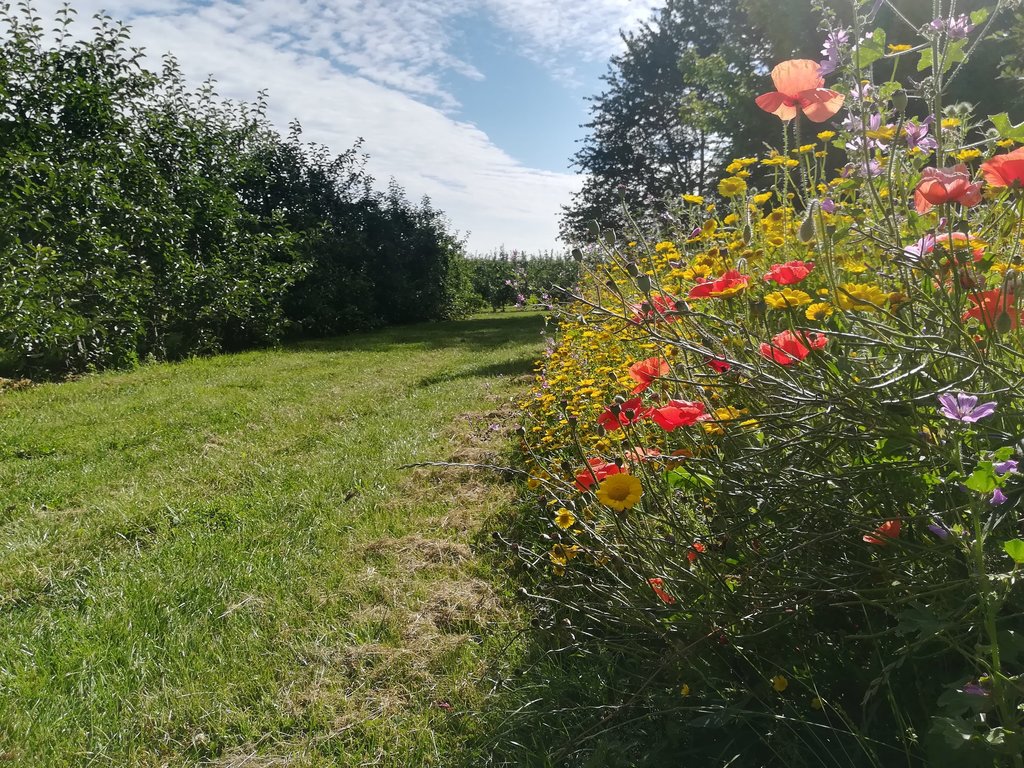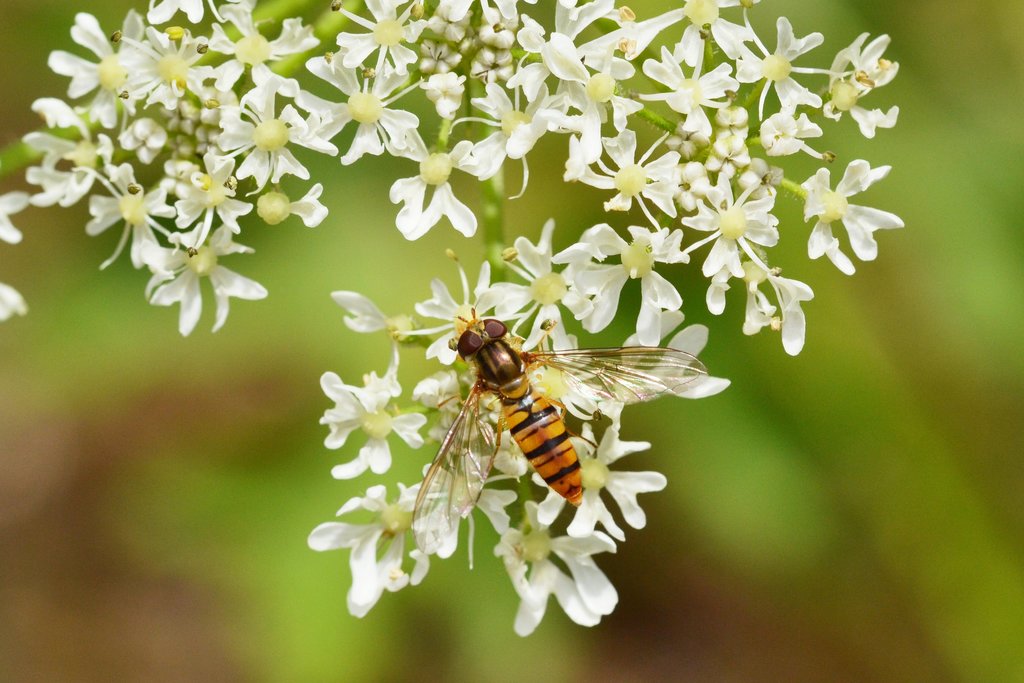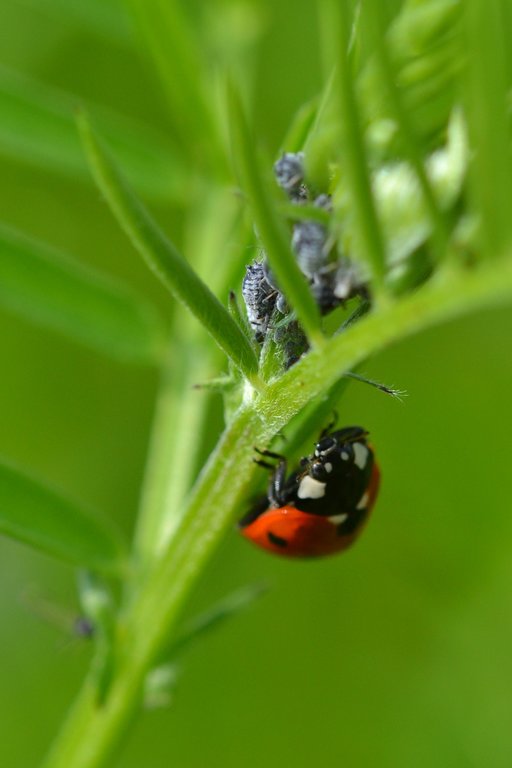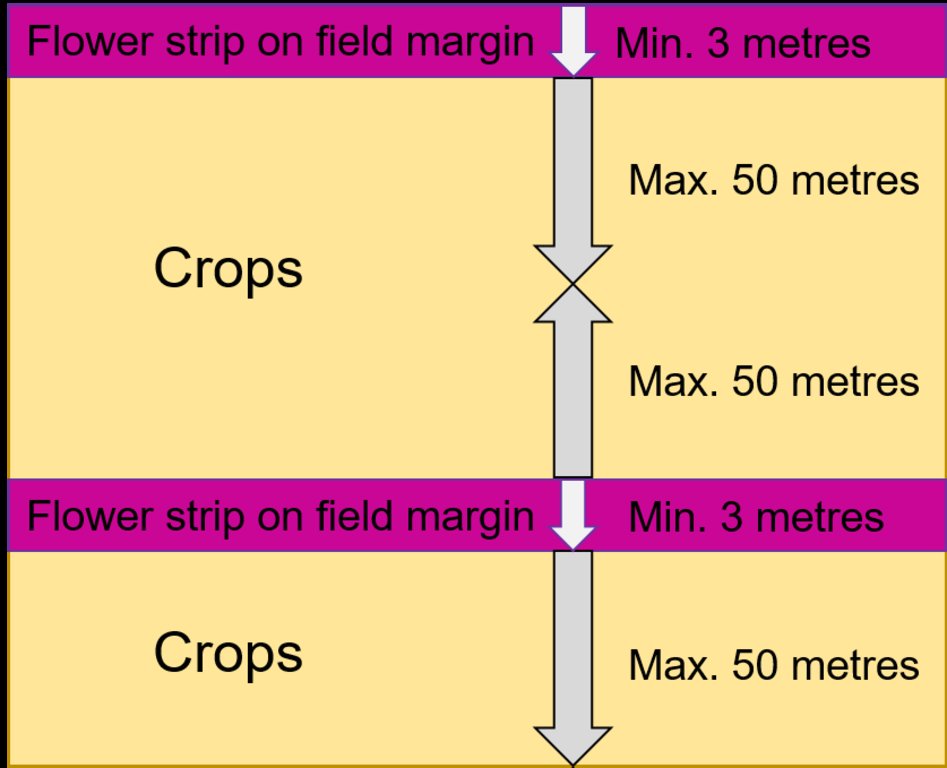Flower strips on field margins to attract beneficial insects [Belgium]
- Creation:
- Update:
- Compiler: Alan Radbourne
- Editors: David Norris, Sabine Reinsch
- Reviewers: William Critchley, Rima Mekdaschi Studer
technologies_5620 - Belgium
View sections
Expand all Collapse all1. General information
1.2 Contact details of resource persons and institutions involved in the assessment and documentation of the Technology
Key resource person(s)
co-compiler:
D’Hooghe Mathias
agrobeheercentrum Eco²
Belgium
Name of project which facilitated the documentation/ evaluation of the Technology (if relevant)
European Interreg project FABulous FarmersName of the institution(s) which facilitated the documentation/ evaluation of the Technology (if relevant)
UK Centre for Ecology & Hydrology (CEH) - United KingdomName of the institution(s) which facilitated the documentation/ evaluation of the Technology (if relevant)
Biobest Group (Biobest Group) - Belgium1.3 Conditions regarding the use of data documented through WOCAT
The compiler and key resource person(s) accept the conditions regarding the use of data documented through WOCAT:
Ja
1.4 Declaration on sustainability of the described Technology
Is the Technology described here problematic with regard to land degradation, so that it cannot be declared a sustainable land management technology?
Nee
2. Description of the SLM Technology
2.1 Short description of the Technology
Definition of the Technology:
Field margins in agricultural areas are sown with specific flowers to attract insects which help combating pests of crops and livestock and reduce the need for pesticides.
2.2 Detailed description of the Technology
Description:
Flower strips on field margins have been established in the centre of Belgium in the region ‘Pajottenland’. The Pajottenland is predominantly farmland and lies mostly between the rivers Dender and Senne in close proximity to Brussels. Pajottenland has historically provided food and drink for the citizens of Brussels. This SLM practice was established in September 2019 on parcels on 7 different farms in Pajottenland. Such flower strips are 3-12 metres wide and are established at the edges of fields to provide nectar and pollen to attract beneficial species that control pest species. It is estimated the beneficial effect of the flower strips on field margins extends about 50 metres into the field.
The strips provide a habitat for natural enemies of various crop and livestock pests to control and decrease their population and to reduce the necessity of spraying pesticides. Care it taken in choosing and sowing flower species that attract arthropods with a role in biocontrol, such as hoverflies, lacewings, parasitoids and ladybirds. The flower strips conserve ecosystems and improve biodiversity, also facilitating ecosystem-based disaster risk and integrated soil fertility management.
Farmers dedicate strips of land on field margins to flowers (perennial herbaceous plants). Work includes management of the soil, sowing seeds, mowing flowers and removal of residues. Costs are related to farmers working hours, sowing and mowing equipment, pesticides (if necessary) and seed costs. Savings are related to providing a habitat for natural pest controls, thereby reducing pest in crops and increasing yields.
What do land users like about the technology?
- increased recreational impact for humans due to the beauty of the flower strips
- increased biodiversity (beyond natural pest enemies)
What do land users dislike about the technology?
- reduced overall income from crops (due to reduced area)
- the costs - unless subsidies become more widely available
The compilation of this SLM is a part of the European Interreg project FABulous Farmers which aims to reduce the reliance on external inputs by encouraging the use of methods and interventions that increase the farm’s Functional AgroBiodiversity (FAB). Visit www.fabulousfarmers.eu and www.nweurope.eu/Fabulous-Farmers for more information.
2.3 Photos of the Technology
2.5 Country/ region/ locations where the Technology has been applied and which are covered by this assessment
Country:
Belgium
Region/ State/ Province:
Flemisch Brabant
Further specification of location:
Pajottenland
Specify the spread of the Technology:
- applied at specific points/ concentrated on a small area
Is/are the technology site(s) located in a permanently protected area?
Nee
Map
×2.6 Date of implementation
Indicate year of implementation:
2019
2.7 Introduction of the Technology
Specify how the Technology was introduced:
- during experiments/ research
- through projects/ external interventions
Comments (type of project, etc.):
Interreg North West Europe: FABulous farmers
3. Classification of the SLM Technology
3.1 Main purpose(s) of the Technology
- preserve/ improve biodiversity
- Reduced pesticide use
3.2 Current land use type(s) where the Technology is applied
Land use mixed within the same land unit:
Nee

Cropland
- Annual cropping
- Various crop types used in a regional effort to implement flowerstrips
Number of growing seasons per year:
- 1
Is intercropping practiced?
Nee
Is crop rotation practiced?
Nee
3.3 Has land use changed due to the implementation of the Technology?
Has land use changed due to the implementation of the Technology?
- No (Continue with question 3.4)
3.4 Water supply
Water supply for the land on which the Technology is applied:
- rainfed
3.5 SLM group to which the Technology belongs
- integrated pest and disease management (incl. organic agriculture)
3.6 SLM measures comprising the Technology

agronomic measures
- A1: Vegetation/ soil cover

vegetative measures
- V2: Grasses and perennial herbaceous plants
3.7 Main types of land degradation addressed by the Technology

biological degradation
- Bp: increase of pests/ diseases, loss of predators
3.8 Prevention, reduction, or restoration of land degradation
Specify the goal of the Technology with regard to land degradation:
- not applicable
4. Technical specifications, implementation activities, inputs, and costs
4.1 Technical drawing of the Technology
Technical specifications (related to technical drawing):
Dimension flower strip: minimum 3 metres wide
Effect of the flower strips goes up to 50 metres
Sowing= 2 g seeds/m²= 20 kg seeds/hectare
Author:
Mathias D’Hooghe
Date:
02/10/2019
4.2 General information regarding the calculation of inputs and costs
Specify how costs and inputs were calculated:
- per Technology area
Indicate size and area unit:
1 ha
If using a local area unit, indicate conversion factor to one hectare (e.g. 1 ha = 2.47 acres): 1 ha =:
1ha - 2.47 acres
other/ national currency (specify):
€
If relevant, indicate exchange rate from USD to local currency (e.g. 1 USD = 79.9 Brazilian Real): 1 USD =:
0.91
Indicate average wage cost of hired labour per day:
240
4.3 Establishment activities
| Activity | Timing (season) | |
|---|---|---|
| 1. | Soil strip preparation | Spring |
| 2. | Planting wildflower seed | Spring |
| 3. | Mowing wildflowers | Late-Summer |
| 4. | Residue removal | Late-Summer (before crop harvest) |
4.4 Costs and inputs needed for establishment
| Specify input | Unit | Quantity | Costs per Unit | Total costs per input | % of costs borne by land users | |
|---|---|---|---|---|---|---|
| Labour | Farmer time for establishment | Days per establishment | 3.0 | 240.0 | 720.0 | 100.0 |
| Equipment | Machine to cultivate the land (already owned by farmer) | 1 | 1.0 | 100.0 | ||
| Equipment | Machine for sowing after cultivating (already owned by farmer) | 1 | 1.0 | 100.0 | ||
| Equipment | Mower to cut and clear flowers (already owned by farmer) | 1 | 1.0 | 100.0 | ||
| Plant material | Flower seeds | per ha | 1.0 | 900.0 | 900.0 | 30.0 |
| Other | Loss of income with reduction of cultivated area for crops due to flower strips | ha | 1.0 | 500.0 | 500.0 | 100.0 |
| Total costs for establishment of the Technology | 2120.0 | |||||
| Total costs for establishment of the Technology in USD | 2329.67 | |||||
Comments:
In 2019 farmers working with VLM who provide a subsidy to sow and maintain field margins at ~70% of the costs to embed and maintain the flower margins.
4.5 Maintenance/ recurrent activities
Comments:
No on-going maintenance. The technology would be re-established as required
4.7 Most important factors affecting the costs
Describe the most determinate factors affecting the costs:
Cost of seed mix
Cost of machines to embed and maintain the flower strips if not already available to farmer
5. Natural and human environment
5.1 Climate
Annual rainfall
- < 250 mm
- 251-500 mm
- 501-750 mm
- 751-1,000 mm
- 1,001-1,500 mm
- 1,501-2,000 mm
- 2,001-3,000 mm
- 3,001-4,000 mm
- > 4,000 mm
Specify average annual rainfall (if known), in mm:
751.00
Specifications/ comments on rainfall:
Rain spread throughout the year
Indicate the name of the reference meteorological station considered:
KMI, VMM
Agro-climatic zone
- sub-humid
5.2 Topography
Slopes on average:
- flat (0-2%)
- gentle (3-5%)
- moderate (6-10%)
- rolling (11-15%)
- hilly (16-30%)
- steep (31-60%)
- very steep (>60%)
Landforms:
- plateau/plains
- ridges
- mountain slopes
- hill slopes
- footslopes
- valley floors
Altitudinal zone:
- 0-100 m a.s.l.
- 101-500 m a.s.l.
- 501-1,000 m a.s.l.
- 1,001-1,500 m a.s.l.
- 1,501-2,000 m a.s.l.
- 2,001-2,500 m a.s.l.
- 2,501-3,000 m a.s.l.
- 3,001-4,000 m a.s.l.
- > 4,000 m a.s.l.
Indicate if the Technology is specifically applied in:
- not relevant
5.3 Soils
Soil depth on average:
- very shallow (0-20 cm)
- shallow (21-50 cm)
- moderately deep (51-80 cm)
- deep (81-120 cm)
- very deep (> 120 cm)
Soil texture (topsoil):
- medium (loamy, silty)
Soil texture (> 20 cm below surface):
- medium (loamy, silty)
Topsoil organic matter:
- medium (1-3%)
- low (<1%)
5.4 Water availability and quality
Ground water table:
< 5 m
Availability of surface water:
good
Water quality (untreated):
poor drinking water (treatment required)
Water quality refers to:
ground water
Is water salinity a problem?
Nee
Is flooding of the area occurring?
Nee
5.5 Biodiversity
Species diversity:
- medium
Habitat diversity:
- medium
Comments and further specifications on biodiversity:
To be increased by SLM.
5.6 Characteristics of land users applying the Technology
Sedentary or nomadic:
- Sedentary
Market orientation of production system:
- mixed (subsistence/ commercial)
- commercial/ market
Off-farm income:
- less than 10% of all income
Relative level of wealth:
- average
Individuals or groups:
- individual/ household
Level of mechanization:
- mechanized/ motorized
Gender:
- men
Age of land users:
- middle-aged
- elderly
5.7 Average area of land used by land users applying the Technology
- < 0.5 ha
- 0.5-1 ha
- 1-2 ha
- 2-5 ha
- 5-15 ha
- 15-50 ha
- 50-100 ha
- 100-500 ha
- 500-1,000 ha
- 1,000-10,000 ha
- > 10,000 ha
Is this considered small-, medium- or large-scale (referring to local context)?
- medium-scale
5.8 Land ownership, land use rights, and water use rights
Land ownership:
- individual, titled
Land use rights:
- leased
Water use rights:
- open access (unorganized)
Are land use rights based on a traditional legal system?
Ja
Specify:
Royal decrees, rent legislation
5.9 Access to services and infrastructure
health:
- poor
- moderate
- good
education:
- poor
- moderate
- good
technical assistance:
- poor
- moderate
- good
employment (e.g. off-farm):
- poor
- moderate
- good
markets:
- poor
- moderate
- good
energy:
- poor
- moderate
- good
roads and transport:
- poor
- moderate
- good
drinking water and sanitation:
- poor
- moderate
- good
financial services:
- poor
- moderate
- good
6. Impacts and concluding statements
6.1 On-site impacts the Technology has shown
Socio-economic impacts
Production
crop quality
Comments/ specify:
Beneficial species control pests that leads to improved crop quality
Income and costs
expenses on agricultural inputs
Comments/ specify:
More beneficial species and fewer pests reduces reliance on pesticide use
Ecological impacts
Biodiversity: vegetation, animals
beneficial species
Comments/ specify:
Flowers attract more beneficial species
pest/ disease control
Comments/ specify:
Flowers attract more beneficial species that can control pests and diseases
6.4 Cost-benefit analysis
How do the benefits compare with the establishment costs (from land users’ perspective)?
Short-term returns:
positive
Long-term returns:
positive
Comments:
'Positive' with the support of subsidies.
6.5 Adoption of the Technology
- 1-10%
Of all those who have adopted the Technology, how many did so spontaneously, i.e. without receiving any material incentives/ payments?
- 0-10%
Comments:
Support provided by SLM expert and subsidised establishment costs
6.6 Adaptation
Has the Technology been modified recently to adapt to changing conditions?
Nee
6.7 Strengths/ advantages/ opportunities of the Technology
| Strengths/ advantages/ opportunities in the land user’s view |
|---|
| Reduced reliance on pesticide use |
| Landscape diversity and colourful appearance |
| Strengths/ advantages/ opportunities in the compiler’s or other key resource person’s view |
|---|
| Improved crop quality and health with natural pest control and more beneficial species for pollination, reduces inputs and labour |
| Social benefit with attractive flower strips in landscape |
6.8 Weaknesses/ disadvantages/ risks of the Technology and ways of overcoming them
| Weaknesses/ disadvantages/ risks in the land user’s view | How can they be overcome? |
|---|---|
| Loss of production land for crops | Costs offset by reduced pesticide use and potential for improved crop quality |
| Expensive seed mix | Subsidy for implementation |
| Weaknesses/ disadvantages/ risks in the compiler’s or other key resource person’s view | How can they be overcome? |
|---|---|
| Speciailst knowledge required for right seed mix | SLM expert support and more training opportunities provided through projects like FAB Farmers |
7. References and links
7.1 Methods/ sources of information
- field visits, field surveys
SLM expert supported implementation thorough the FAB Farmers Project
- interviews with land users
SLM expert supported implementation thorough the FAB Farmers Project
When were the data compiled (in the field)?
01/09/2019
7.4 General comments
This SLM technology is an excellent and easy way to reduce pesticide use and provide other benefits in-kind. The key challenge is to use the correct flower seed mix to attract the most beneficial species for the farm and crop.
Links and modules
Expand all Collapse allLinks
No links
Modules
No modules


